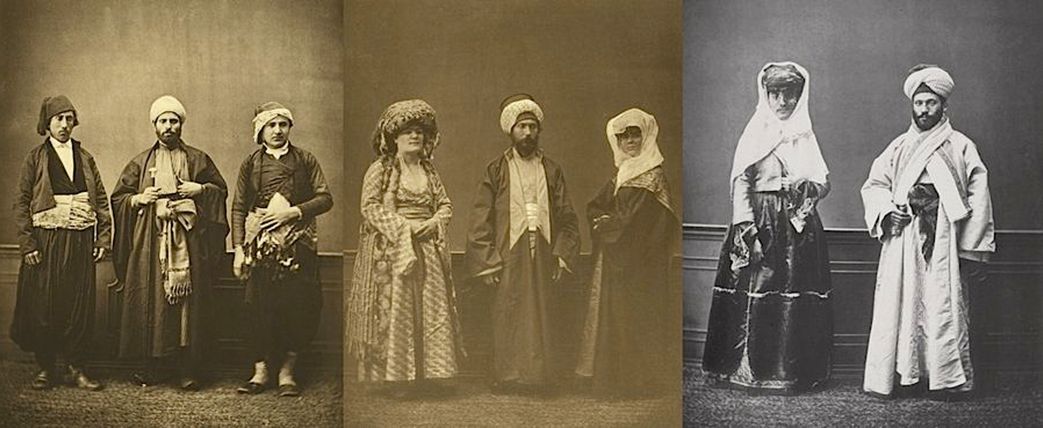[su_quote cite=”Quote, ascribed to Sultan Abdülhamid the Second.”]Her fotoğraf bir fikirdir. Bazen tek bir fotoğraf, yüzlerce sayfalar dolusu yazıdan daha fazla siyasi ve duygusal önem taşıyabilir. İşte bu nedenle yazılı belgelerden ziyade fotoğrafların yardımına başvurmayı tercih ediyorum.
(Every photograph is an idea. Sometimes a single photograph conveys more political and emotional importance than thousands of pages full of writing. For this reason I prefer to appeal more to the help of photographs than to written documents.)[/su_quote]
The late 19th century was a period of many transformations for the Ottoman Empire, as it actually was for the entire world. Lots of new techniques and machines were being developed, which would, over time, thoroughly affect people’s lives. One of this new technologies was photography. Also in the Ottoman Empire, it proved to be a whole new medium and instrument to record reality. Some of the most famous photographers were the Abdullah Brothers.

They had been made court photographers by Sultan Abdülaziz and would later be commissioned by sultan Abdülhamid II to document the changes the Empire was undergoing. In order to promote the image of his empire, the sultan made sure that copies were sent to both the Library of Congress and the British Museum (photo’s now held in the British Library). Photographs are also kept at the Istanbul University Manuscript Library. An interesting fact about the Abdullah Brothers is that they were not Turks, but Armenians (one of the Christian peoples of the Ottoman Empire). More than often, pioneering work was done by members of the non-Muslim minorities of the Empire. After all, Muslim orthodoxy frowned upon the representation of human figures. Moreover, they stood often into contact with Western Europe, which facilitated the use of new technologies. Kevork Abdullah, for instance, had studied at the Mourad-Raphaelyan School in Venice. At the same time, lots of non-Muslims also converted to Islam during the existence of the Empire. This was the case for Viçen Abdullah, who converted to Islam.
Another pioneer in orientalist photography was Pascal Sébah. He had been born in 1823 to a Syrian Catholic father and an Armenian mother in Constantinople, then the cosmopolitan and vibrant capital of the Empire.

His father is reported to have been from a Levantine (present-day Lebanon) background. He would open his first photographic studio in 1857. This studio was called El Charck (the Orient) and was located on the Postacılar Street in Péra. Péra, modern day Beyoğlu, was where most of these photographers were located, as it was and still is the most Western-oriented part of town. And the name of the business is also very telling. The interest of Europeans in the east was growing in those days. Cities like Constantinople, Damascus and Cairo where places of legends for western audiences. This was one of the circumstances, which made his success possible, as postcards could be sold to travellers visiting the tourist sites of Turkey, Greece and Egypt. Moreover he started to collaborate with the French technician Antoine Laroche in 1860, what greatly enhanced the quality of his images.
One of the things which made his name very well known is the 1873 World Exhibition in Vienna. His contributions consisted of a series of photographs, which depict the various traditional costumes of the Ottoman Empire at that time. For this he co collaborated with Osman Hamdi Bey, the founder of the Istanbul Archaeological Museums. The pictures were all published in a 370 pages long album and accompanied by long and detailed descriptions giving more context and explanations.

Other projects with added to his fame were the many photographs he took in Istanbul and his two panorama’s of the city. One was made from the Galata tower (2.5 m long) and the other from the Beyazıt Tower. Besides, he also made a five-part panorama of Cairo. He was able to do this since he had opened a branch studio in Cairo in 1873. There he would exchange some negatives with H. Bechard, who had been working in Cairo since 1870. Each set their own signatures to the other’s negatives, which can lead to some confusion. His pictures of Egypt and Cairo fired the imagination as much as the ones he had made in Istanbul. All this resulted in him winning some medals and in becoming a member of the Société Française de Photographie. Just as the aforementioned Abdullah frères he was commissioned by Sultan Abdülhamid the Second to record the changes the Empire was undergoing. During the war with Russia of 1877-1878 he was even ordered by Sultan Abdülhamid II to document the suffering of Muslims, especially women. These photographs made it into the French magazine Le Monde illustré.
To decades of long work came an end when Pascal Sébah suffered a stroke. His business was taken over by his brother Cosmi and later by his son Jean Sébah (1872-1947) and the Frenchman Policarpe Joallier (active from 1848 to 1904), which lead to the creation of Sébah & Joallier. Pascal Sébah died on 25 June 1886 and was buried at the Feriköy Latin Cemetery in Istanbul. Sébah and Joallier continued to be a prestigious photographic studio and years of long work were crowned in 1890 with the permission to be called “Photographers to the Sultan,” albeit too late for Pascal Sébah to have witnessed this himself.
[su_slider source=”media: 4769,4771,4772,4773,4774,4775,4776,4777,4778,4779,4780,4781,4782,4783,4784,4785,4786,4787,4788,4789″ link=”lightbox” height=”500″ pages=”no” autoplay=”0″]
